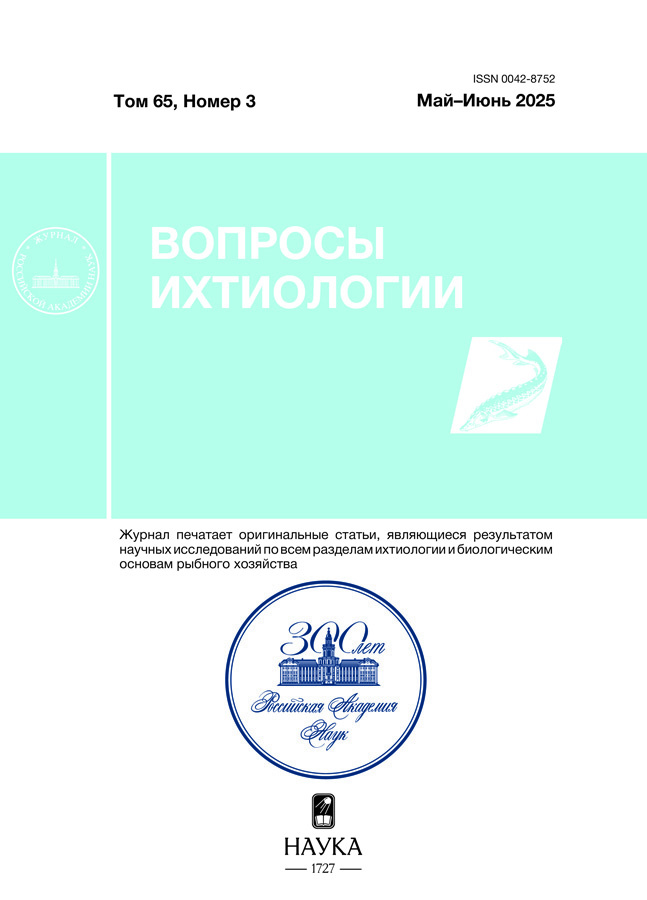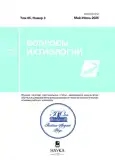Морфофункциональная характеристика эритрона крови сингиля Chelon auratus (Mugilidae) на ранних этапах онтогенеза
- Авторы: Солдатов А.А.1,2, Рокотова А.Г.1, Кухарева Т.А.1, Рычкова В.Н.1
-
Учреждения:
- Институт биологии южных морей РАН — ИнБЮМ РАН
- Севастопольский государственный университет — СевГУ
- Выпуск: Том 65, № 3 (2025)
- Страницы: 364-371
- Раздел: Статьи
- URL: https://gynecology.orscience.ru/0042-8752/article/view/688142
- DOI: https://doi.org/10.31857/S0042875225030098
- EDN: https://elibrary.ru/FHETWU
- ID: 688142
Цитировать
Полный текст
Аннотация
В первый год жизни сингиля Chelon auratus (Risso, 1810) активно наращивается циркулирующая эритроцитарная масса. Уровень полихроматофильных нормобластов, отражающий интенсивность эритропоэтических процессов в гемопоэтической ткани, в периферическом кровеносном русле сеголеток достигает максимальных значений. Внутриклеточный синтез гемоглобина при этом менее интенсивен и сопровождается появлением в крови гипохромных эритроцитов. Среднее содержание гемоглобина в эритроците минимально — 28.9 ± 0.8 пг (у трёхлеток — 37.1 ± 0.8 пг). В крови сеголеток и двухлеток доминируют крупные эритроциты (объём 96.9 ± 4.1 мкм3) с высокими значениями ядерно-цитоплазматического отношения (0.121 ± 0.011), которое понижается к третьему году жизни по мере роста среднего содержания гемоглобина в эритроците (R2 = 0.851). В крови двухлеток отмечено высокое содержание эритроцитарных аномалий (до 14% эритроидных клеток): дакриоциты, клетки с инвагинацией ядра, эритроцитарные тени. Присутствие дакриоцитов в крови данной возрастной группы отражает развитие состояния гипоксии. Из представленных результатов следует, что первый год в жизненном цикле сингиля является наиболее критичным. Это необходимо учитывать при разведении вида в условиях рыбоводных хозяйств.
Ключевые слова
Полный текст
Об авторах
А. А. Солдатов
Институт биологии южных морей РАН — ИнБЮМ РАН; Севастопольский государственный университет — СевГУ
Автор, ответственный за переписку.
Email: alekssoldatov@yandex.ru
Россия, Севастополь; Севастополь
А. Г. Рокотова
Институт биологии южных морей РАН — ИнБЮМ РАН
Email: alekssoldatov@yandex.ru
Россия, Севастополь
Т. А. Кухарева
Институт биологии южных морей РАН — ИнБЮМ РАН
Email: alekssoldatov@yandex.ru
Россия, Севастополь
В. Н. Рычкова
Институт биологии южных морей РАН — ИнБЮМ РАН
Email: alekssoldatov@yandex.ru
Россия, Севастополь
Список литературы
- Давыдов О.Н., Темниханов Ю.Д., Куровская Л.Я. 2006. Патология крови рыб. Киев: ИНКОС, 206 с.
- Павлов Д.А. 2004. Морфологическая изменчивость в раннем онтогенезе костистых рыб и ее эволюционное значение: Автореф. дис. ... докт. биол. наук. М.: МГУ, 52 с.
- Солдатов А.А. 1994. Локализация и пролиферативная активность очагов эритропоэза в онтогенезе кефали-сингиля Liza aurata // Журн. эволюц. биохимии и физиологии. Т. 30. № 4. С. 567–574.
- Солдатов А.А., Парфенова И.А. 2014. Гемоглобиновая система кефали-сингиля (Liza aurata, Risso) при адаптации к условиям внешней гипоксии // Там же. Т. 50. № 1. С. 72–77.
- Солдатов А.А., Рычкова В.Н., Кухарева Т.А., Рокотова А.Г. 2023. Клеточный состав эритроидных форм в крови и головной почке кефали-сингиля (Chelon auratus Risso, 1810) на протяжении годового цикла // Рос. физиол. журн. им. И.М. Сеченова. T. 109. № 7. С. 990–1001. https://doi.org/10.31857/S0869813923070130
- Ташкэ К. 1980. Введение в количественную цито-гистологическую морфологию. Бухарест: Изд-во АН СР Румыния, 291 с.
- Фащук Д.Я. 2019. Черноморская кефаль: как возродить былую славу? // Природа. № 11 (1251). С. 20–31. https://doi.org/10.7868/S0032874X19110036
- Шекк П.В. 2012. Биолого-технологические основы культивирования кефалевых и камбаловых. Херсон: ЧП Гринь, 306 с.
- Шекк П.В., Куликова Н.И., Руденко В.И. 1990. Возрастные изменения реакции черноморского сингиля Liza aurata на низкую температуру // Вопр. ихтиологии. Т. 30. Вып. 1. С. 94–106.
- Ayllon F., Garcia-Vazquez E. 2000. Induction of micronuclei and other nuclear abnormalities in European minnow Phoxinus phoxinus and mollie Poecilia latipinna: an assessment of the fish micronucleus test // Mutat. Res. Genet. Toxicol. Environ. Mutagen. V. 467. № 2. P. 177–186. https://doi.org/10.1016/s1383-5718(00)00033-4
- Bakhshalizadeh S., Liyafoyi A.R., Saoca C. et al. 2022. Nickel and cadmium tissue bioaccumulation and blood parameters in Chelon auratus and Mugil cephalus from Anzali free zone in the south Caspian Sea (Iran) and Faro Lake (Italy): a comparative analysis // J. Trace Elem. Med. Biol. V. 72. Article 126999. https://doi.org/10.1016/j.jtemb.2022.126999
- Ergene S., Çavaş T., Çelik A. et al. 2007. Monitoring of nuclear abnormalities in peripheral erythrocytes of three fish species from the Goksu Delta (Turkey): genotoxic damage in relation to water pollution // Ecotoxicology. V. 16. № 4. P. 385–391. https://doi.org/10.1007/s10646-007-0142-4
- Fazio F., Saoca C., Acar Ü. et al. 2020. A comparative evaluation of hematological and biochemical parameters between the Italian mullet Mugil cephalus (Linnaeus 1758) and the Turkish mullet Chelon auratus (Risso 1810) // Turk. J. Zool. V. 44. № 1. P. 22–30. https://doi.org/10.3906/zoo-1907-37
- Girish V., Vijayalakshmi A. 2004. Affordable image analysis using NIH Image/ImageJ // Indian J. Cancer. V. 41. № 1. Р. 47.
- Houchin D.N., Munn J.I., Parnell B.L. 1958. A method for the measurement of red cell dimensions and calculation of mean corpuscular volume and surface area // Blood. V. 13. № 12. P. 1185–1191. https://doi.org/10.1182/blood.V13.12.1185.1185
- Houston A.H. 1990. Blood and circulation // Methods for fish biology. Bethesda: Am. Fish. Soc. P. 273–334. https://doi.org/10.47886/9780913235584.ch9
- Kulkeaw K., Sugiyama D. 2012. Zebrafish erythropoiesis and the utility of fish as models of anemia // Stem Cell Res. Ther. V. 3. № 6. Article 55. https://doi.org/10.1186/scrt146
- Nita V., Nenciu M. 2020. Biological and ethological response of Black Sea golden grey mullet (Chelon auratus Risso, 1810) fries to different salinities and temperatures // Turk. J. Fish. Aquat. Sci. V. 20. № 11. P. 777–783. https://doi.org/10.4194/1303-2712-v20_11_01
- Shahriari Moghadam M., Abtahi B., Mosafer Khorjestan S., Bitaab M.A. 2013. Salinity tolerance and gill histopathological alterations in Liza aurata Risso, 1810 (Actinopterygii: Mugilidae) fry // Ital. J. Zool. V. 80. № 4. P. 503–509. https://doi.org/10.1080/11250003.2013.853326
- Strunjak-Perovic I., Topic Popovic N., Coz-Rakovac R., Jadan M. 2009. Nuclear abnormalities of marine fish erythrocytes // J. Fish Biol. № 74. № 10. P. 2239– 2249. https://doi.org/10.1111/j.1095-8649.2009.02232.x
Дополнительные файлы














